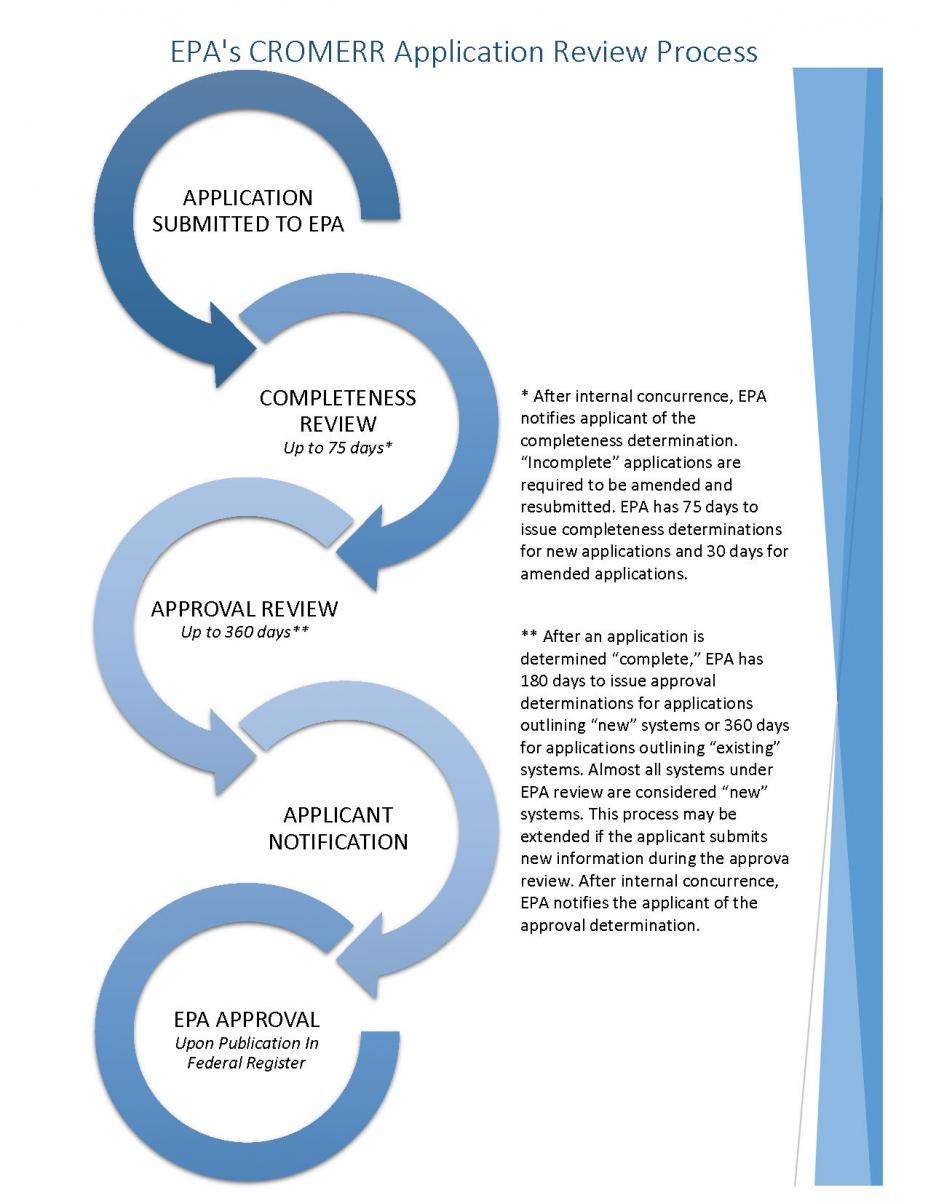CROMERR Overview for State, Tribal and Local Governments
On this page:
Background
Published on October 13, 2005, the Cross-Media Electronic Reporting Rule (CROMERR) established a framework by which EPA will accept electronic reports from regulated entities. CROMERR may apply to any electronic document submission required by or permitted under any EPA or authorized program governed by EPA's regulations in Title 40 of the Code of Federal Regulations (CFR).
See: CROMERR Federal Register Notices
Under CROMERR, subject electronic reporting systems require EPA approval. The regulation provides a framework for applying for and obtaining such approval. EPA approval is based primarily on an assessment of how an authorized program's electronic reporting system meets the performance-based criteria outlined in CROMERR. The criteria are technology-neutral so that authorized programs can determine the most appropriate technology for their program.
In addition to including criteria for electronic reporting systems, CROMERR also established an alternate approval process for such systems. Specifically, authorized programs may also choose to apply for approval of electronic reporting for a specific program by using the applicable regulatory program approval or revision processes under other Parts of 40 CFR. Authorized programs pursuing this alternative must still comply with CROMERR standards. This alternative process is not coordinated by the CROMERR program, but by EPA program offices and Regions as applicable.
Program impact
Authorized programs that receive or plan to receive electronic reports may apply to the EPA CROMERR Technical Review Committee (TRC) for an assessment and formal EPA action. Applications can address one or more authorized program. System certification by the TRC is based on an assessment of how electronic reporting systems meet the technology-neutral, performance-based criteria in CROMERR.
The performance-based criteria address a number of topics, including:
- Criteria for establishing a copy of record,
- Integrity of electronic document,
- Opportunity to review and repudiate copy of record,
- Validity of electronic signature, and
- Determination of the identity of the individual uniquely entitled to use a signature device.
All CROMERR-subject systems must receive EPA approval before going into production. A system is considered to be “in production” when regulated entities start registering to report electronically through the system.
Overview of the application process
Documentation required, review and approval timeframes can vary greatly based on system approach.
Authorized programs pursuing substantially custom-developed systems may experience lengthy review timeframes and may need to incorporate significant changes to their approach to ensure consistency with CROMERR standards. To minimize rework, applicants implementing such approaches are encouraged to work with the CROMERR program during the design phase and to submit system documentation for draft review.
Authorized programs pursuing EPA and commercial off-the-shelf solutions benefit from substantially reduced risk of CROMERR compliance concerns. Early engagement is typically not needed for applicants pursuing off-the-shelf solutions.
A CROMERR application traditionally consists of:
- A certification that existing laws or regulations provide the legal authority to implement and enforce electronic reporting, signed by the State Attorney General or the chief administrative official of tribal or local governments;
- A list of the electronic document receiving systems for which approval is being requested and a description of how each system will satisfy the requirements of CROMERR; and
- A schedule of upgrades that may affect CROMERR compliance.
See: Application Tools and Templates for information about how to prepare these materials to minimize review, documentation that may have been waived for particular system approaches, and for pre-populated templates that may be available for particular system approaches. Applicants pursuing EPA and commercial off-the-shelf solutions typically have significantly reduced documentation requirements.
The CROMERR application process traditionally consists of several steps:
- Application preparation and submittal,
- Confirmation and processing,
- Committee review,
- Comments and response,
- Internal EPA approval,
- Approval notification and Federal Register publication, and
- Modifications to approved applications.
These steps and the diagram below outline the traditional review and approval process outlined in the regulation and still followed for custom-developed systems. Applicants pursuing EPA and commercial off-the-shelf solutions typically proceed through these steps quickly and/or do not go through all of these steps. Therefore, they benefit from expedited approval. As of 2017, 80 percent or more of current applicants pursue off-the-shelf solutions.

For further information about CROMERR, see: CROMERR 101: Fundamentals for States, Tribes and Local Governments
Note: To be consistent with language in the final rule, this website uses the term “state” to include the District of Columbia, the Commonwealth of Puerto Rico, the Virgin Islands, Guam, American Samoa, the Commonwealth of Northern Marina Islands, and the Trust Territory of the Pacific Islands, depending on the statute.
